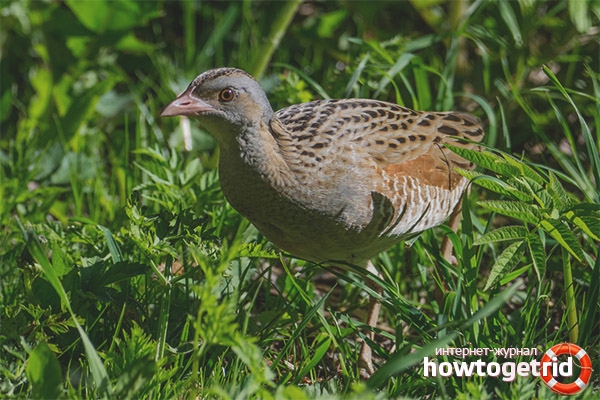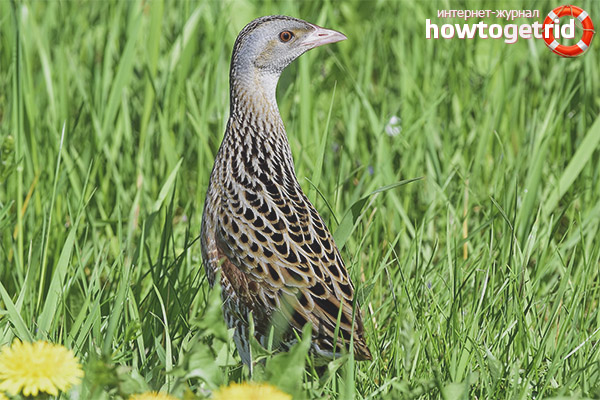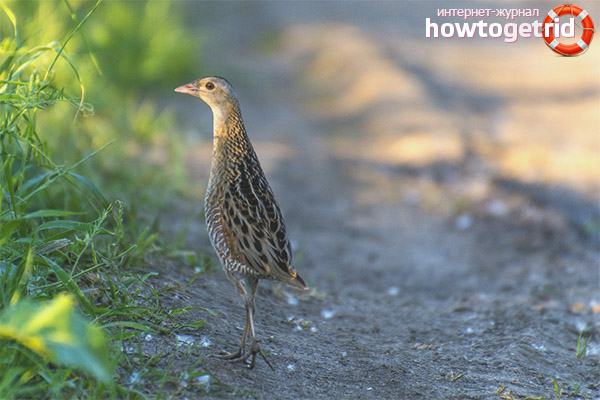The content of the article
Corncrake is an interesting species of birds, attracting the attention of many bird lovers. Particularly noteworthy is the fact that representatives of this species do not really like to fly. The second common name for this small bird is dergach.
This species of birds is very common and probably many of the people, if not seen, then heard the sound of the voice of these birds. As a rule, you can hear a dergach in the evening in open areas (meadows, large glades), the bird makes characteristic crackling sounds, reminiscent of the croaking of toads.
View description
In its size, the crust is a little chicken, the maximum weight of an individual reaches 155-160 grams. From the side, the body of the dergach seems somewhat flattened, the tail of the bird is quite long, the beak is small and wide at the base, the wing length does not exceed 16 cm.
The color of the plumage of the upper part of the bird is quite variegated, red-brown color predominates. The abdomen and sides of the crust are ocherous, decorated with characteristic red stripes. The craw, neck and sternum of the dergach are gray. Iris - a pleasant nutty shade.
Habitat
The nesting site of the dergach is practically the entire territory of Eurasia. As a place for wintering, this species of birds is chosen mainly by the southeast of the African continent. As a rule, for the settlement of their colonies, dergachs prefer to choose floodplain meadows overgrown with perennial dense vegetation, uncultivated gardens, semi-arid areas found in marshy areas. Also, these miniature birds are often found on grain fields. A prerequisite for the nesting of the corncrake is the presence of a reservoir, however, the humidity level in the territory chosen for life should not be excessive.
Voice Features
During the mating season, dergach's cries are heard almost at any time of the day or night, with the sounds made by the males, the coronelles males attract not only the attention of the females, but also challenge the potential competitors and rivals.
Often during mating games, the bird enters into such excitement, singing its jerky trills that it may not even be heard if any animal or even a person has approached it. This is due to the fact that during singing the bird, in fact, stuns itself. During singing, the dergach strongly extends its neck forward and spins in different directions.
Korostel emits unusually loud and sharp cries when there is any danger to her, a bit like chirping of a bird like a magpie.
Lifestyle features

The best place for nesting dergach is wet, overgrown with tall and dense vegetation meadows. You can also often meet birds of this species in the fields with cereals.
The corostel bird can be attributed to nocturnal birds, which in good weather can actively communicate with their relatives throughout the night, get to write, sing songs and only go to rest in the morning.
It is incredibly difficult to notice a dergach in the dense grass, because representatives of this species are extremely rare in the air.
Dergachi run fast (thanks to the narrow and maneuverable body), while bending the front of the body to the surface of the earth and pulling the tail up. During the movement, it seems that the bird constantly nods its head, periodically during such a “cross” the dergach stops abruptly and extends its neck forward the entire length, looking around the area around it. After inspection, the bird makes a characteristic sound, as if encouraging itself with the fact that there is no threat to its life.
Having sensed the approach of the slightest danger or threat from predatory species of birds or animals, the bird will first of all try to flee from his opponent in order to hide from him in the thick and tall grass. If there is no way to escape, it rises into the air. However, this makes the dergach quite awkward and slow. During the flight, the feathered legs are lowered down, the flight duration is very short, flying several tens of meters, the bird again descends into thickets of dense vegetation.
Propagation Features
Corostel can be quite called sequentially polygamous birds. The mating season begins in mid-spring and ends in July. As mentioned above, in this period of time the birds become very active and loud, in addition to their original “songs” in sound, the males also attract the attention of their friends with characteristic mating dances, spreading spectacular wings with red spots and a circle on the surface of the earth. Often, during courtship, a dergach feeds his girlfriend with caught animals - small worms and snails.
For one mating season, a male dergach can mate with several females. The duties of a loving gentleman do not include the construction of nests, as well as caring for future offspring. As soon as the female dergach begins to lay eggs, her gentleman immediately escapes in search of a new darling.
The construction and arrangement of the nest is exclusively carried out by the female corncrake, as a rule, a place for it is chosen among small bushes or in dense grass. To begin with, a small depression is buried in the ground, lined with stalks of cereals, the bottom is lined with moss. The number of eggs in one clutch reaches 10-12 pieces.
The duration of the hatching of future offspring is about 3 weeks. The appeared chicks have a downy outfit of dark brown color. Almost immediately after hatching, small crusts can leave the parent nest, accompanying the female in search of food.
The first weeks, the female dergach feeds its offspring from the beak. When the young growth reaches two weeks, the chicks begin to lead a completely independent lifestyle. Young dergachs at the age of 1 month become winged, after which they completely abandon parental care.
Power Features
The diet of this type of bird as a corolla consists of both plant and animal food. Due to the fact that for their nesting sites, feathered birds choose fertile territories - as a rule, they do not have problems with obtaining the necessary food. For example, colony of dergach living near the grain fields feed on worms, insects, and cereal grains.
Species population
Due to the fact that the corostel is a very careful bird, it is therefore practically impossible to determine the exact number of individuals of this species. Nevertheless, many experts believe that the population of the dergach is gradually decreasing, which is associated with a change in the landscape.
Video: Corncrake (Crex crex)











Submit